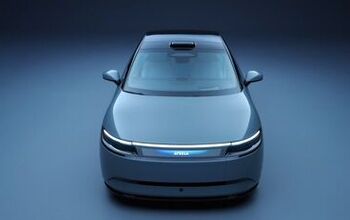Opinion: The Bentley Crash in New York is Scrambling Brains

Last week, on the day before Thanksgiving, a middle-aged couple in a Bentley met a fiery end under mysterious circumstances near the U.S.-Canada border outside of Buffalo, New York.
We know the victims names – Kurt Villani, 53, and his wife, Monica Villani, also 53 – and we know that they were in a Bentley Flying Spur (no jokes about the name, please). What we don’t know is why the car accelerated to a high rate of speed and went airborne before becoming a fireball.
Mechanical failure? Drunk driving? Health issue? The driver simply having a leadfoot?
We do know, despite a breathless and apparently unsourced Fox News report, that it wasn’t a terrorist attack.
I could focus on Fox’s failure to do proper journalism, but that’s beyond our purview and has been covered extensively by journalists who cover the media.
More to our speed is this Slate piece which came to my attention via a tweet from Car and Driver senior editor Andrew Krok. The article is a doozy of automotive ignorance. According to Krok, Kois never even reached out Car and Driver to ask about the Bentley.
First, a disclosure and a caveat. The disclosure here is that Krok and I once worked together at a different company, and the caveat is that I often find interesting, well-written pieces on Slate. So I don’t think it’s fair to tar the whole publication here. But the writer and any editors involved should really be able craft a better, less ignorant argument.
Before we go further, go back and read the link if you haven’t already. It won’t take long. OK, good, you’re done. Let’s go.
What caught my eye was Krok highlighting this bit: “Why would an automaker manufacture a car with so much engine power that it requires an eight-speed transmission?” There’s a lot more that’s wrong with this piece, but let’s start there.
I understand that someone who isn’t a car person – and I have no idea of what level of automotive knowledge Kois possesses – might make an unfortunate correlation between the number of gears in a transmission and the amount of power a car’s engine possesses. But, of course, the two aren’t necessarily related.
Indeed, the Jeep Compass I am testing now makes only 200 horsepower – more than 300 less than the Bentley – and 221 lb-ft of torque, yet it also uses an eight-speed automatic transmission. The Compass is a nice little ‘ute, but it’s not being mistaken for a Bentley anytime soon.
A high-schooler in auto-shop class will understand how a transmission works. Hell, a bicyclist will get it. Lower gears are used to help acceleration while higher gears are set up for cruising and maximizing fuel economy. It’s all about keeping your engine in the right rev range the situation, and having more gears helps do that, which can allow for better performance and fuel economy.
That’s obviously an oversimplification, but we have more to do here.
Kois’s answers his question by saying that the answer is obvious – people will pay more for more powerful cars. This is, actually, fairly accurate – sports cars are more desired than econoboxes because they’re more fun to drive for enthusiasts. Though he ignores the other reasons a wealthy person might buy a Bentley – style, creature comforts, as an indication of socioeconomic status, and so on. We don’t know why Villani owned a Bentley. Power and top speed may not have been a motivating purchase factor.
Kois goes on to rail on the new Ferrari movie because it “fetishizes” speed and then goes on to chastise the film for glorifying fast driving. He later takes the film to task for how it shows the deaths of drivers in wrecks caused, at least in part, by excessive speed. Never mind that the film is likely simply presenting fact, or at least fact as has been recorded – I haven’t yet seen the film – and that racing safety has improved over the years. One big improvement in racing safety? Restricting officially sanctioned car racing to actual racetracks.
Kois seems to take Enzo Ferrari to task for wanting to sell cars based on their ability to perform at high speed on a racetrack. Somehow it escapes his mind that just because someone buys a Corvette or a Mustang based on its ability, it doesn’t mean that the driver is going to actually drive it on public roads as if they’re at a racetrack. Some drivers will take their cars to the track and work them out, others will mostly hew to the speed limit save for an occasional foray into speed on a lightly-trafficked back road.
Furthermore, one can drive hard enough to have fun without speeding excessively.
Yes, some morons will wrap a Mustang around a tree or pulled a Henry Ruggs with their new Corvette. Irresponsible people walk among us, and sometimes even the responsible make a poor decision. I wish it didn’t happen, but it does. That doesn’t mean we shouldn’t be allowed to buy a car that has a high potential top speed.
Nor do I think we should allow the government to put speed limiters in our cars.
To be clear, I am not some madman defending speeding. I am fully aware that it takes longer to stop the faster you’re going, and that the faster you’re going when you hit something, the more damage it does. Basic physics cannot be denied. I also believe that you should keep your speed low – under 30 or 25 mph – when driving through residential areas.
Similarly, one should slow down when rain or snow make the roads slick, or the weather hampers visibility.
I am firmly against street racing – take that stuff to the track. Speaking of the track, again, if you have a high-performance car and want to fully exercise it, taking it there is the only safe option.
Furthermore, I believe context matters when it comes to speed – 80 in a 65 on a limited-access interstate is not the same as 40 in a 25 zone on street full of suburban homes, even if both are 15 mph over the limit.
But I digress. The point here isn’t just to push back against “speed kills” pearl-clutching. It’s to show that Kois’s premise is half-baked.
Again, speeding in certain contexts really, truly is dangerous. Blasting down bustling city streets or through residential zones is bad – and that type of driving can, of course, lead to an increase in pedestrian deaths.
Data did show that traffic deaths and pedestrian deaths spiked during the pandemic. And to give Kois credit, he’s not entirely wrong to point out that the increase in vehicle sizes, especially as it pertains to trucks and SUVs, can increase the likelihood of pedestrian deaths. Basic physics, again, cannot be denied.
That said, perhaps the pandemic blip was just that? I know my anecdotal experiences aren’t data, but the roads seem packed again. When I drive on the freeway, it’s not a Mad Max dystopian hellhole – people speed a bit, but relatively few are excessively over the limit. Most of the truly bad driving I see has less to do with speed than maneuvering – poor lane changes and the like.
Kois is all over the place in his piece – he seems to argue that A) you shouldn’t want to buy a fast car, even if you could afford one, because it might tempt you to drive way too fast; B) all cars should have strict governors (the OEM-installed 155-mph ones aren’t enough) to further prevent temptation; C) Americans are driving way too fast in general and often in vehicles that are very big; D) that if we see a movie that glorifies fast driving we’ll somehow treat the Miracle Mile as if it’s the Mille Miglia; and F) excessive speeding must be the cause of the crash in New York.
To rebut point by point: A) People have agency and while some morons resist self-control, most people can and do drive their cars at far lower speeds than they are capable of, whether they drive a Buick or a Bentley; B) Since most people are capable of driving like responsible adults, I don’t think this level of government intrusion in our lives is necessary – and I say this as a liberal who is far from a “don’t tread on me” type; C) His data is based on what is likely a pandemic blip and one Google search of recent accidents on Texas highway with a high speed limit. Never mind that perhaps some of the accidents linked were perhaps the same ones being covered by multiple news outlets. Maybe there’s better data about accidents on that highway ever since the speed limits were raised?
Finally, D and F: I’ve seen several racing movies, enjoy watching real-life car racing, have played Gran Turismo and Grand Theft Auto. I do enjoy driving fast, when the situation allows me to do so safely. Yet I am not tearing ass down Irving Park road at 80 mph. I, and I presume most other drivers, aren’t going to drive EVERYWHERE WE GO as if we’re one of Enzo’s drivers trying to win a thousand-mile long road race. A movie won’t inspire sudden bouts of hooning on the way home from the cineplex.
As for F, we know the car was speeding, but we don’t know WHY. Maybe we’ll find out, maybe we won’t. But it seems a strange news hook to peg an unfocused, factually-challenged anti-speed screed on.
What happened in New York was a tragedy, especially for those who knew the Villanis. But thanks to agendas held by those with large platforms, it became a pet cause. One major news outlet with a partisan slant decided to make it about terrorism, without evidence. A writer for a major online opinion/analysis outlet that has a partisan lean in the other direction decided to use an isolated accident as a way to rail against – well I am not sure what. Expensive luxury/performance cars? The lack of strict speed governors in modern automobiles? Americans driving like crazy people? All of the above?
If Dan Kois wants us to live in a world where we all drive cheap, underpowered cars that are limited to 85 mph, he has that right. But I’m happy to live in the real world, where I can buy a fast car if I can afford it, and drive it like a responsible adult on public roads and like a wannabe racecar driver on a track (again, if I can afford it). A world where even a lowly $20K car isn’t too strictly speed-limited by on-board tech. A world where, some idiots who cause carnage (and sadly, real tragedies) aside, most of us play close enough to the rules.
Of course, plenty of us also know how a transmission works.
[Image: Bentley]

Tim Healey grew up around the auto-parts business and has always had a love for cars — his parents joke his first word was “‘Vette”. Despite this, he wanted to pursue a career in sports writing but he ended up falling semi-accidentally into the automotive-journalism industry, first at Consumer Guide Automotive and later at Web2Carz.com. He also worked as an industry analyst at Mintel Group and freelanced for About.com, CarFax, Vehix.com, High Gear Media, Torque News, FutureCar.com, Cars.com, among others, and of course Vertical Scope sites such as AutoGuide.com, Off-Road.com, and HybridCars.com. He’s an urbanite and as such, doesn’t need a daily driver, but if he had one, it would be compact, sporty, and have a manual transmission.
More by Tim Healey
Latest Car Reviews
Read moreLatest Product Reviews
Read moreRecent Comments
- Peter Buying an EV from Toyota is like buying a Bible from Donald Trump. Don’t be surprised if some very important parts are left out.
- Sheila I have a 2016 Kia Sorento that just threw a rod out of the engine case. Filed a claim for new engine and was denied…..due to a loop hole that was included in the Class Action Engine Settlement so Hyundai and Kia would be able to deny a large percentage of cars with prematurely failed engines. It’s called the KSDS Improvement Campaign. Ever hear of such a thing? It’s not even a Recall, although they know these engines are very dangerous. As unknowing consumers load themselves and kids in them everyday. Are their any new Class Action Lawsuits that anyone knows of?
- Alan Well, it will take 30 years to fix Nissan up after the Renault Alliance reduced Nissan to a paltry mess.I think Nissan will eventually improve.
- Alan This will be overpriced for what it offers.I think the "Western" auto manufacturers rip off the consumer with the Thai and Chinese made vehicles.A Chinese made Model 3 in Australia is over $70k AUD(for 1995 $45k USD) which is far more expensive than a similar Chinesium EV of equal or better quality and loaded with goodies.Chinese pickups are $20k to $30k cheaper than Thai built pickups from Ford and the Japanese brands. Who's ripping who off?
- Alan Years ago Jack Baruth held a "competition" for a piece from the B&B on the oddest pickup story (or something like that). I think 5 people were awarded the prizes.I never received mine, something about being in Australia. If TTAC is global how do you offer prizes to those overseas or are we omitted on the sly from competing?In the end I lost significant respect for Baruth.


































Comments
Join the conversation
Proportional speeding fines make more sense than hard number fines in most cases. 40 in a 30 zone is 33% over, 100 in a 75 zone is 33% over, 65 in a 50 zone is 18% over, 40 in a 25 zone is 60% over; which one of those scenarios is the more dangerous? Every 41% increase in speed doubles kinetic energy making collisions 2x more severe. Stopping distances tend to correlate closely with kinetic energy 2x the energy available means it takes 2x the distance to stop; in reality slightly more because reaction time is relatively constant at any speed. Power limiting of vehicles is necessary for reasons of climate damage control. 5 hours use of an average midrange SUV adds as much heat to the ecosystem as an average person's body heat does in an entire year. In 1 year of use at 5 hours per day the vehicle adds as much heat to the ecosystem as 365 average persons. this figure only includes the lopsses at the vehicle not supply chain, processing, and fuel delivery losses. Limiting vehicle power to only necessary levels would make the amount of heat added to the environment 1/3 or less, switching to electric vehicles with the same amount of reduced power can cut the total waste heat generated by a vehicle to less than 2% of the original 5 hours=1 year equivalency; when the entire oil pumping, transportation, storage, fuel production, delivery, and supply chain is added into the waste heat numbers.
Great. You know more trivia about cars than the reporter. Here’s your cookie.
Meanwhile that car is a dangerous monstrosity that nobody needs. Automated acceleration? Give me a break. It’s like the plane with the automated “crash into ground” feature.